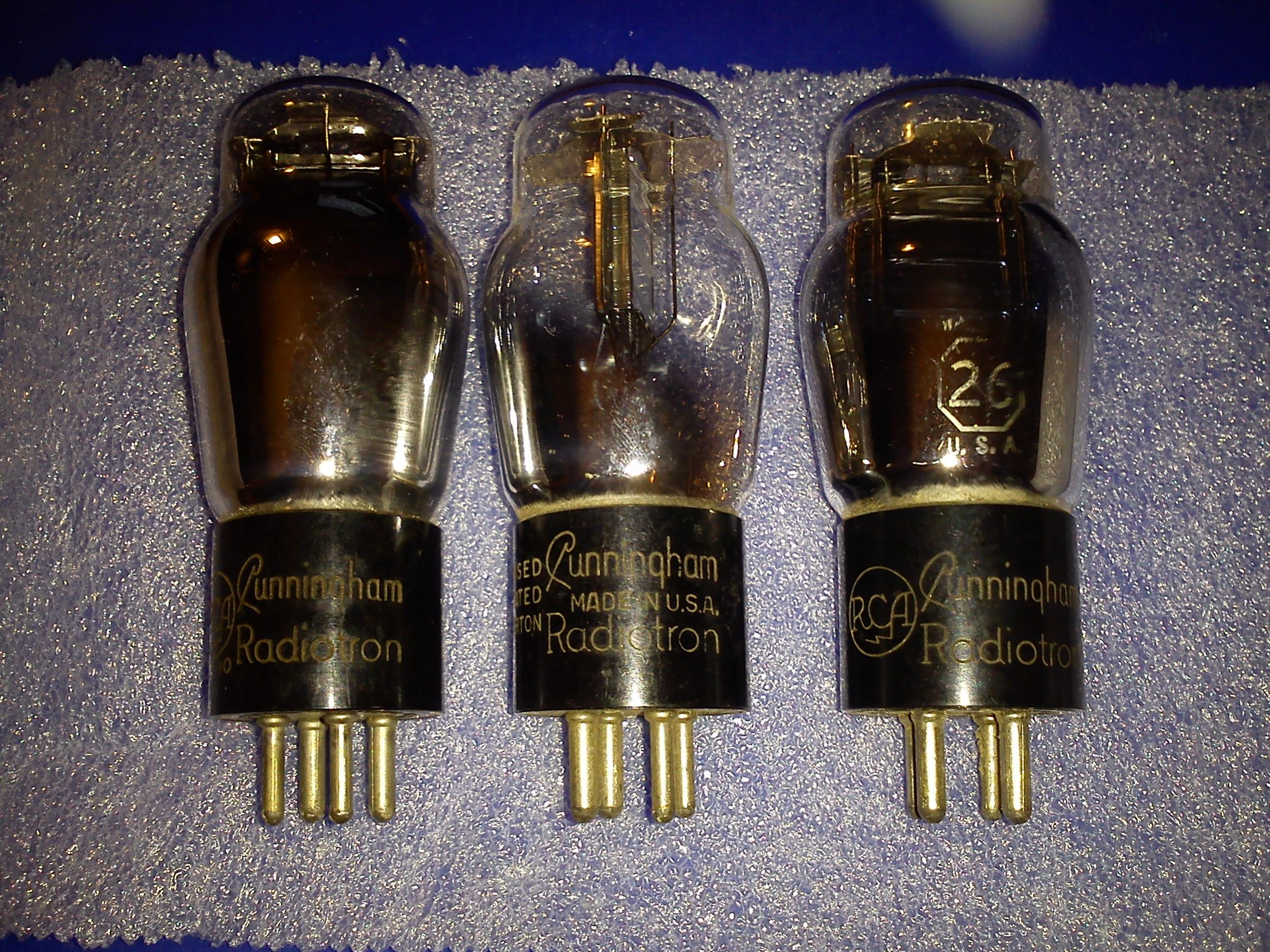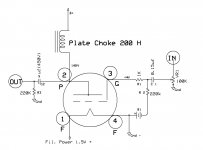Just a quick word about batteries for grid bias. I got some A23 batteries to try out. These are 12v and quite small - 28mm long and 10mm diameter. Users of battery bias may find these more useful than the usual PP3 at 9v, though clearly those are widely available and have a longer life. Anyone tried A23 batteries or can suggest if they are powerful enough for the job?
Energizer A23 Pack of 2 Batteries: Amazon.co.uk: Garden & Outdoors
They fit N size battery holders
N Size Battery Holders : Battery Boxes : Maplin
Andy
Energizer A23 Pack of 2 Batteries: Amazon.co.uk: Garden & Outdoors
They fit N size battery holders
N Size Battery Holders : Battery Boxes : Maplin
Andy
Actually, I found a 15v battery, 45mAh:
VARTA|V74PX.|BATTERY, 15V | Farnell United Kingdom
Haven't looked for the battery holder yet.
This raises the possibility of running the 26 at 180v and 15v bias, which would be about 5mA. I'm starting to wonder if that could be used as a driver tube for an output like a 2a3 or even a 300b!!
Andy
VARTA|V74PX.|BATTERY, 15V | Farnell United Kingdom
Haven't looked for the battery holder yet.
This raises the possibility of running the 26 at 180v and 15v bias, which would be about 5mA. I'm starting to wonder if that could be used as a driver tube for an output like a 2a3 or even a 300b!!
Andy
Thanks Andy. You confirmed my observation with CX-326 plate curves. I was little in doubt whether I did it right.
Rod, thanks for your information. This is something new for me to learn. BTW, I tried different tubes with similar plate/bias voltage figures but scenario was almost same. Anyway I will test the few of these tubes for gas as you described and report.
Rod, thanks for your information. This is something new for me to learn. BTW, I tried different tubes with similar plate/bias voltage figures but scenario was almost same. Anyway I will test the few of these tubes for gas as you described and report.
Kanishka, are you sure that the SMPS bias is not generating the noise?
Many SMPS operating from the mains line can show leakage current from L to safety Earth. Even if the ripple on the output is low, you may get noise from this current leakage.
Comparing with a battery will prove quickly if this is worth looking into.
Many SMPS operating from the mains line can show leakage current from L to safety Earth. Even if the ripple on the output is low, you may get noise from this current leakage.
Comparing with a battery will prove quickly if this is worth looking into.
Kanishka, are you sure that the SMPS bias is not generating the noise?
Many SMPS operating from the mains line can show leakage current from L to safety Earth. Even if the ripple on the output is low, you may get noise from this current leakage.
Comparing with a battery will prove quickly if this is worth looking into.
Thanks Rod. This make sense. I will change the bias supply and see. I remember when I used battery before, it was less noise. BTW, is there an easy way of getting rid of this leakage from SMPS? If there is, it will reduce my time to build a different PSU.
Last edited:
Just a quick observation - I tried the globe 26 against the ST version, and found I preferred the globes. Slightly more definition in the mid and treble. Anyone else have views?
andy
Could you post a pic to see the differences?
Felipe
Just a quick observation - I tried the globe 26 against the ST version, and found I preferred the globes. Slightly more definition in the mid and treble. Anyone else have views?
andy
For my ears as well, the globe are certainly better than ST's. Globes are having better control across all the frequencies I believe. Very rich sound that pleasing to the ears. Super Silvertone and Tung-sol are the only ST's coming closer to the sound of the globes as I observed. I prefer Silvertones above all other ST's because of the faster sound they produce. Cunningham is the best overall sound from globes that I found. Both are very musical tubes and pleasure to listen. Tested Cunningham, RCA, Silvertones, Tungsol, Blue Acturus, Philco, and Superairlines so far.
Last edited:
Just a quick observation - I tried the globe 26 against the ST version, and found I preferred the globes. Slightly more definition in the mid and treble. Anyone else have views?
andy
Fully agree. I listened today Andy's pre-amp and it's superb. Globes had a better treble indeed.
Worth following Andy's advice on DHTs...
Cheers, Ale
Hi!
R3 is there to avoid static charge build up on the output when nothing is connected. This avoids that you hear a loud plop when you plug the preamp into a power amo which is on.
R3 should not have a big impact since it is in parallel with the input resistance of your power amp anyways. If the preamp reacts to such tiny changes in load impedance, something is not optimal.
Do you really run at -16V bias? The way the filament is drawn this results in an average of -16,75V. At 140V thats maybe 2-3mA or even less. That marginal op point is probably the reason why you hear a difference when you remove R3.
What you don't really need is R1. The 26 is low transconductance and not prone to parasitic oscillation. I'd use it without a grid stopper.
Best regards
Thomas
R3 is there to avoid static charge build up on the output when nothing is connected. This avoids that you hear a loud plop when you plug the preamp into a power amo which is on.
R3 should not have a big impact since it is in parallel with the input resistance of your power amp anyways. If the preamp reacts to such tiny changes in load impedance, something is not optimal.
Do you really run at -16V bias? The way the filament is drawn this results in an average of -16,75V. At 140V thats maybe 2-3mA or even less. That marginal op point is probably the reason why you hear a difference when you remove R3.
What you don't really need is R1. The 26 is low transconductance and not prone to parasitic oscillation. I'd use it without a grid stopper.
Best regards
Thomas
Hi!
Another comment:
The 26 has a rather highish miller capacitance of about 65pF. Driven from a high impedance pot, this can already impact treble response audibly.
If your sources allow it, go for a lower impedance pot.
Of course a transformer volume control driven by a 26 through a step down transformer is even better.
Best regards
Thomas
Another comment:
The 26 has a rather highish miller capacitance of about 65pF. Driven from a high impedance pot, this can already impact treble response audibly.
If your sources allow it, go for a lower impedance pot.
Of course a transformer volume control driven by a 26 through a step down transformer is even better.
Best regards
Thomas
Coolzero - is that a 5uF output capacitor? Is this going straight into a tube amp stage? Is it so close to it so leads can be very short? If that is true, and you have say 270k to 470K total input resistance on the amp (your two resistors in parallel) then a smaller capacitor would give you much better sound, because you could use a better quality capacitor. I'd use Russian 0.1uF Teflon FT-2 or FT-3 in whatever numbers give you a good enough bass response. Parallel for 0.2, 0.3 etc.
I have short leads to my amp and I use a single Teflon 0.1uF FT-2 cap. Inevitably capacitors will have some effect on the sound so this part must be optimised.
If you have a transistor amp that's another story, but surely you don't?
Andy
I have short leads to my amp and I use a single Teflon 0.1uF FT-2 cap. Inevitably capacitors will have some effect on the sound so this part must be optimised.
If you have a transistor amp that's another story, but surely you don't?
Andy
- Home
- Amplifiers
- Tubes / Valves
- #26 pre amp

